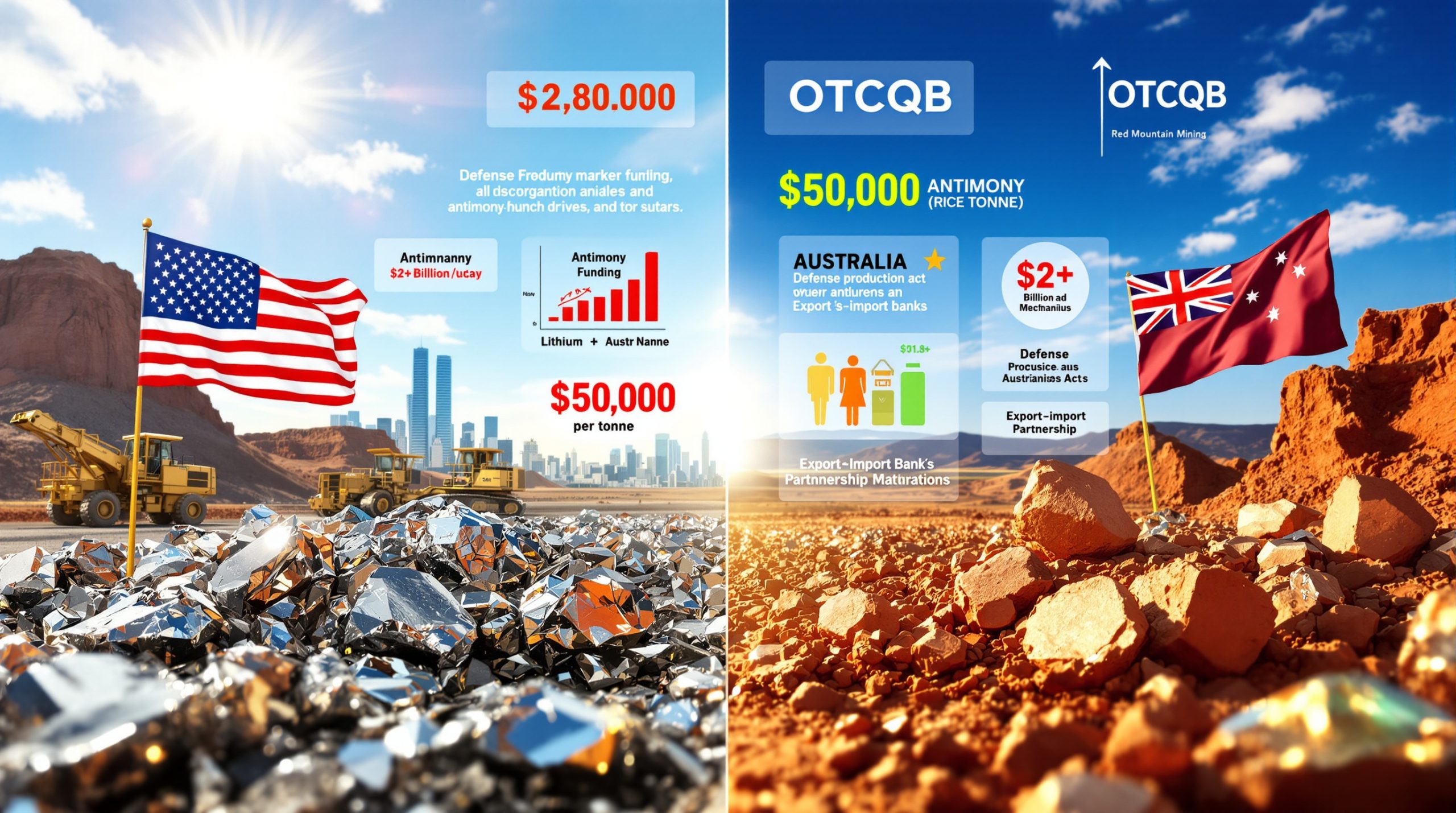The Battery Metals Conundrum: Understanding Supply and Demand Dynamics
As the global energy transition accelerates, battery metals have become critical components of modern economies. However, these markets operate with unique dynamics that create both challenges and opportunities for investors, manufacturers, and policymakers alike.
What Are the Current Supply-Demand Fundamentals in Battery Metals?
The battery metals market demonstrates complex supply and demand relationships that vary significantly across different metals. Understanding these differences is crucial for strategic decision-making in this rapidly evolving sector.
Understanding the Unique Market Dynamics of Each Battery Metal
Battery metals don't follow uniform market patterns. Each metal—copper, lithium, nickel, and rare earths—has distinct supply-demand characteristics, market sizes, and pricing mechanisms. These differences create varied investment opportunities across the battery metals spectrum.
As Chris Berry, president of House Mountain Partners, explains: "We've never seen supply and demand balance in lithium. There's either been oversupply like we have right now or undersupply like we saw in recent years."
This cyclical nature creates recurring investment opportunities for those who understand the timing of these markets and can position accordingly before the broader market recognizes the shifts.
Copper: The Essential Foundation Metal
Copper stands apart from other battery metals with its remarkable price stability and diverse applications. As Berry notes, "Copper is one of the few battery metals that hasn't seen huge price downdrafts. It really is one of the single essential metals, period."
Recent copper price insights suggest continued strength despite economic headwinds. Key copper market characteristics include:
- Multi-sector demand: Beyond EVs, copper is critical for electrical grids, construction, and traditional industries
- Supply constraints: Grade decline in major mines coupled with few new discoveries
- Price resilience: Demonstrated ability to maintain value even during economic downturns
- Infrastructure necessity: Electrical grid expansion requires massive copper investment
This combination of factors makes copper potentially the most attractive long-term investment in the battery metals space, offering both growth potential and relative stability.
Lithium: A Market in Pricing Disconnect
The lithium market currently exists in a state of significant pricing imbalance. According to Berry, "Lithium at $8,500 per ton for lithium carbonate is completely out of whack relative to what this industry needs in terms of an incentive price and the capital that it needs to grow."
Industry analysis indicates the market requires $20,000-22,000 per ton to incentivize the new capacity needed to meet projected demand growth. This disconnect presents both risks and opportunities:
- Demand growth: Lithium demand is growing at approximately 20% annually
- Supply requirement: Production needs to double between now and 2030
- Historical volatility: Prices reached $85,000 per ton in 2022 during extreme undersupply
- Current oversupply: Inventory buildup has suppressed current pricing
"The lithium market is structurally challenged. It's an opaque, specialized commodity where we've never seen supply and demand balance." — Chris Berry
This cyclical pattern creates windows for strategic investment during price downturns when the long-term demand trajectory remains intact.
How Is the Battery Metals Supply Chain Evolving?
The battery metals supply chain is undergoing significant transformation as countries and companies seek to establish secure and resilient supply networks in an increasingly fractured global landscape.
The Domestic Manufacturing Challenge
Western nations face a critical need for expanded domestic capacity across the entire value chain:
- Cathode manufacturing: Currently dominated by Asian producers
- Anode production: Primarily concentrated in China
- Electrolyte and separator facilities: Essential components with limited Western production
- Recycling infrastructure: Nascent industry with significant scaling challenges
These manufacturing gaps represent both strategic vulnerabilities and investment opportunities as governments prioritize domestic supply chain development.
The Raw Materials Bottleneck
A fundamental "chicken and egg" problem persists in battery supply chain development. As Berry aptly questions: "What is the wisdom in building recycling capacity or cathode capacity if you don't have a lock on the raw materials?"
This dynamic creates several challenges:
- Investment sequencing: Upstream investment must precede or accompany downstream expansion
- Price incentives: Current pricing environment fails to motivate necessary raw material development
- Project economics: Capital costs have increased while commodity prices have decreased
- Securing offtake: Mid and downstream investments require guaranteed access to raw materials
Industry leaders increasingly recognize that controlling raw material supply is the foundation for successful battery supply chain development.
China's Processing Dominance
The central challenge in battery metal supply chains isn't necessarily access to raw materials but rather the processing expertise to convert those materials into usable forms.
Berry explains: "It's not so much the Chinese dominate the mining. They dominate that mid-stream piece, which is turning raw materials into battery grade or magnet grade materials."
This dominance presents significant challenges:
- Processing know-how: China has spent decades developing technical expertise in chemical processing
- Scale advantages: Established facilities with optimized production processes
- Infrastructure network: Integrated supply chains with established logistics
- Government support: Strategic backing for critical industries
According to industry estimates from McKinsey, China controls approximately 60% of global lithium processing and over 85% of rare earth processing capacity. Rebuilding this capability in Western countries requires a decade-long commitment and billions in investment.
What Impact Are Government Policies Having on Battery Metals?
Government policies have become increasingly influential in shaping battery metal markets, creating both opportunities and uncertainties for industry participants.
Shifting Policy Frameworks in the United States
The battery metals sector faces significant policy uncertainty in the United States. As Berry observes: "The tariffs and the threat of export controls are not helpful. There's a lot of uncertainty, and in the business world, uncertainty reigns."
The recent executive order on critical minerals highlights the strategic importance of these resources. Key policy factors include:
- Executive orders: Raising awareness but creating implementation uncertainty
- Tariff policies: Potentially disrupting established supply chains
- Export control threats: Creating anxiety among international partners
- IRA incentives: Potential dismantling creating investment hesitation
These shifting frameworks complicate long-term capital investment decisions in an industry that requires stability and predictability.
Investment Headwinds for Domestic Development
Multiple factors are creating challenging conditions for battery metals investments:
- Higher real interest rates: Increasing project capital costs by 10-20%
- Volatile metals pricing: Creating uncertain revenue projections
- Policy uncertainty: Deterring long-term capital commitments
- Rising construction costs: Inflating capital expenditure requirements
"Uncertainty reigns with what's going to happen with the IRA. Is it going to be dismantled? If so, which pieces? It just slows things down, and we're not in a position where we can slow things down." — Chris Berry
These combined factors create a challenging environment for securing project financing, particularly for earlier-stage companies without established cash flows.
From Energy Transition to National Defense
A notable shift has occurred in the narrative surrounding battery metals development.
"The investment narrative under Biden was clean energy, climate change, and electrification," Berry notes. "Now it's national defense."
Australia has similarly emphasized the importance of a defense-critical materials strategy for long-term security. This narrative shift creates several strategic implications:
- Funding priorities: Defense funding replacing climate-focused incentives
- Scale mismatches: Department of Defense demand insufficient for commercial viability
- "Do it alone" challenges: National security focus potentially hindering international cooperation
- Implementation practicality: Difficulty translating security concerns into commercial projects
While the national security lens elevates the importance of battery metals, it also risks creating inefficient, subscale solutions that don't address the commercial market's needs.
How Are Geopolitical Tensions Reshaping Battery Metal Markets?
Geopolitical factors are fundamentally restructuring global battery metal supply chains, creating new challenges and strategic imperatives for market participants.
Deglobalization Challenges
Despite political rhetoric, completely decoupling from China in battery metals remains practically impossible. As Berry explains: "You can't have a relationship like we have with the Chinese where you've got $500 billion in trade every year just split and not expect to have some pretty significant ramifications."
This reality creates several strategic considerations:
- Partial decoupling: Focusing on critical components rather than complete separation
- Increased costs: Supply chain fragmentation driving higher production expenses
- Longer development timelines: Building parallel supply chains requires patience
- Competitive disadvantages: Higher costs potentially undermining competitiveness
Companies must navigate this complex landscape by developing contingency plans while maintaining efficient supply chains.
The Value Chain Fragmentation Risk
As countries pursue independent, parallel supply chains, significant inefficiencies emerge:
- Duplicated infrastructure: Countries building redundant processing facilities
- Subscale operations: Facilities lacking economies of scale
- Capital inefficiency: Higher per-unit production costs
- Technology transfer challenges: Difficulty rebuilding technical expertise
This fragmentation potentially increases costs across the sector by 20-30%, according to industry analysts. The most successful strategies will focus on securing access to raw materials while building processing capabilities through strategic partnerships.
What Are the Long-Term Investment Considerations?
Looking beyond short-term market volatility, several fundamental factors will shape long-term success in battery metals markets.
Security of Supply as the Primary Concern
"Security of supply matters more than anything else," Berry emphasizes. This reality is driving significant strategic shifts:
- Vertical integration: Companies seeking control across the value chain
- Direct investments: OEMs investing directly in mining companies
- Long-term offtake agreements: Securing supply through contractual commitments
- Geographic diversification: Reducing dependence on single regions
Tesla exemplifies this approach by securing lithium mining rights in Nevada while simultaneously building refining capacity in Texas, demonstrating the strategic importance of controlling multiple supply chain segments.
Technology Innovation as Risk Mitigation
Technology investments provide strategic hedges against metals price volatility and supply constraints:
- Direct lithium extraction boost: Potentially transforming lithium production economics
- Battery chemistry innovations: Reducing dependence on specific metals
- Recycling advancements: Creating significant secondary supply streams
- Process efficiency improvements: Lowering production costs and environmental impact
Recent advances in direct lithium extraction boost production efficiency and reduce environmental impacts. Berry suggests: "You can control metals prices by owning the assets or having offtake agreements, but are there technologies out there that don't use as much of these metals or allow for hedging against metals prices?"
Companies like Lilac Solutions (backed by Bill Gates) and Standard Lithium are pioneering DLE technologies that could dramatically reduce production times and environmental impacts compared to traditional extraction methods.
Realistic Timeframes for Supply Chain Development
Building comprehensive domestic supply chains requires patience and realistic expectations:
- Mine development: Typically 5-15 years from discovery to production
- Processing facilities: 3-5 years from planning to operation
- Technical expertise: Several years to develop specialized workforce
- Regulatory approvals: Multiple years for permitting and environmental review
This extended timeline means that decisions made today will only bear fruit well into the next decade, requiring investors and policymakers to take a long-term perspective despite short-term market fluctuations.
What Are the Most Critical Supply Chain Gaps?
Identifying and addressing key supply chain vulnerabilities is essential for strategic positioning in battery metals markets.
Processing Capacity Deficiencies
The most significant gap in Western battery metal supply chains is midstream processing capacity. According to U.S. Department of Energy data, the United States currently controls less than 5% of global cathode production and minimal lithium refining capability.
Berry explains: "It's not so much finding the raw materials, it's building that processing capacity. That processing capacity has been moved to other countries. It's in China."
Key processing gaps include:
- Chemical refining: Converting concentrates to battery-grade chemicals
- Cathode production: Manufacturing cathode active materials
- Magnet manufacturing: Processing rare earths into permanent magnets
- Advanced material production: Creating specialized battery components
These technical capabilities can't be developed overnight—they require substantial investment in both facilities and human capital.
Capital Allocation Priorities
Strategic capital deployment is essential given the magnitude of investment required across the supply chain:
- Balanced approach: Investments across multiple supply chain segments
- Upstream focus: Securing raw material access before major downstream commitments
- Strategic partnerships: Leveraging complementary capabilities
- Optionality preservation: Maintaining flexibility in rapidly evolving markets
Companies that successfully navigate these allocation decisions position themselves for long-term advantage as markets mature.
How Will Battery Metal Markets Evolve in the Coming Years?
Battery metal markets will continue to evolve through periods of volatility, creating both challenges and opportunities for strategic investors.
Market Volatility Expectations
Price volatility will remain a defining characteristic of battery metals markets:
- Cyclical imbalances: Alternating periods of over and undersupply
- Project delays: Permitting and construction challenges creating supply shortfalls
- Demand uncertainty: EV adoption rates affecting consumption forecasts
- Technological disruption: Chemistry changes impacting specific metal demand
According to BloombergNEF forecasts, lithium prices are projected to recover to approximately $15,000 per ton by 2026 as market balance improves, though still below the $20,000-22,000 incentive price range identified by industry experts.
Structural Supply Challenges
Multiple factors will constrain supply and demand in battery metals in coming years:
- Permitting delays: The National Mining Association reports average U.S. mine permitting takes 7-10 years
- Capital cost increases: Rising by 10-30% due to inflation and interest rates
- Technical challenges: Increasingly complex ores requiring advanced processing
- Environmental standards: Higher requirements extending development timelines
The ongoing critical minerals energy transition highlights these structural challenges. The Thacker Pass lithium project in Nevada illustrates these challenges, having faced years of legal hurdles and permitting delays despite its strategic importance to U.S. supply chains.
Strategic Positioning for Investors
Successful investment strategies will focus on several key factors:
- Vertically integrated operations: Companies controlling multiple supply chain segments
- Secured offtake agreements: Contracts guaranteeing sales and supporting financing
- Technology differentiation: Processes offering cost or environmental advantages
- Jurisdictional advantages: Operations in mining-friendly regions with expedited permitting
These characteristics provide resilience against market volatility and positioning for long-term success as supply chains mature.
FAQ: Battery Metals Supply and Demand
How much must lithium supply increase to meet projected demand?
Lithium supply needs to approximately double between now and 2030 to meet projected demand growth of about 20% annually. Current market pricing does not support this necessary expansion, with lithium carbonate at $8,500 per ton versus an industry-estimated incentive price of $20,000-$22,000 required for new project development.
Why is vertical integration becoming more important in battery metals?
As supply chains fragment due to geopolitical tensions, companies that control both raw materials and processing capacity gain significant competitive advantages. Vertical integration provides security of supply, reduces exposure to market volatility, and enables more predictable costs throughout economic cycles. Tesla's strategy of securing mining rights while building refining capacity exemplifies this approach.
What is the primary bottleneck in developing domestic battery metal supply chains?
The critical bottleneck is midstream processing capacity—converting raw materials into battery-grade products—which has been largely concentrated in China for decades. The United States currently controls less than 5% of global cathode production capacity, creating a significant vulnerability in domestic supply chains that requires both substantial investment and technical expertise to address.
How do government policies impact battery metal investments?
Policy certainty regarding tariffs, export controls, and tax incentives is essential for attracting long-term capital. Current policy uncertainty is delaying investment decisions and project development by creating unpredictable economics. The potential dismantling of Inflation Reduction Act incentives particularly threatens nascent domestic manufacturing initiatives that rely on these supports for economic viability.
What timeframe is realistic for developing domestic battery metal supply chains?
Rebuilding comprehensive domestic supply chains requires at least 5-10 years of sustained investment and policy support. Mine development alone typically takes 5-15 years from discovery to production, while building technical expertise in processing requires significant time and investment. This timeline spans multiple political cycles, highlighting the need for consistent, bipartisan policy approaches to succeed.
Want to Invest in the Next Major ASX Mineral Discovery?
Discovery Alert's proprietary Discovery IQ model instantly identifies significant mineral discoveries on the ASX, turning complex data into actionable investment insights for traders and investors alike. Understand why major discoveries can lead to extraordinary returns by exploring our dedicated discoveries page and begin your 30-day free trial today.




